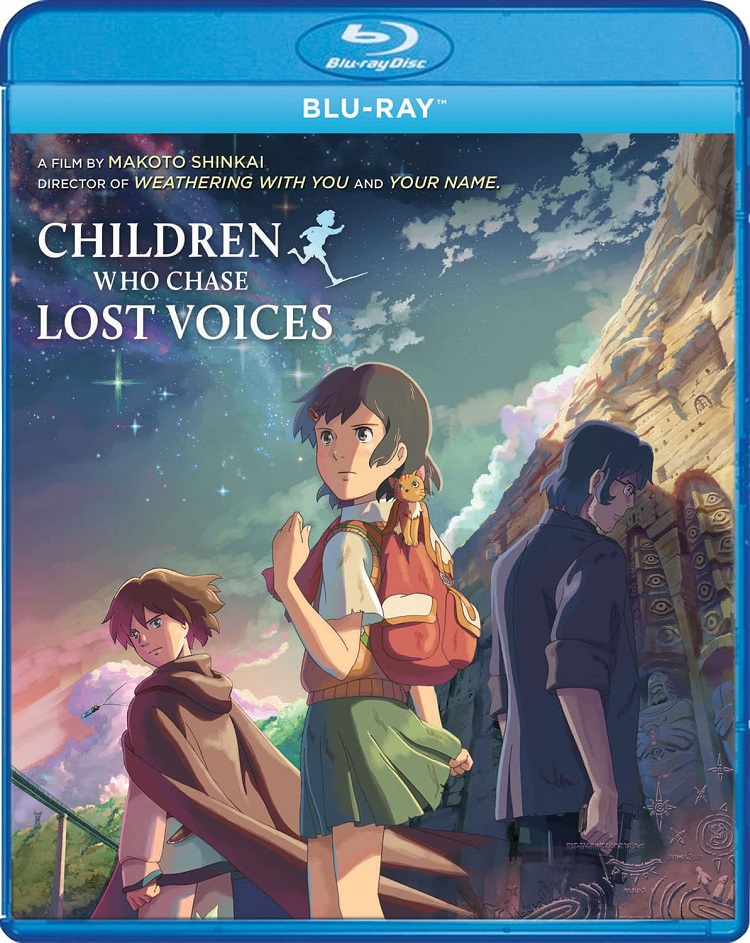
Asuna is a happy girl. She’s lucky to be happy since she spends so much of her time on her own. Her mother works night shifts as a nurse, and Asuna has to go to school, so they barely see each other. She’s lives in the mountains and spends half her time squirreling away supplies in an old bunker, and the rest playing with an old crystal radio set. Normally, she just catches snatches of broadcasts, but one day she hears music like nothing she’s ever heard. She becomes obsessed with finding it again.
Children Who Chase Lost Voices, the third feature film by Makoto Shinkai, is his first fantasy film. It’s also his first film that fully integrates a coherent, understandable plot with sympathetic characters and entertaining action. He’d been compared (a little incoherently) to Miyazaki from his first film. With Children Who Chase Lost Voices, the comparison begins to make more sense.
Not the least of which because some of the visuals and early action of the film are slightly reminiscent of Miyazaki’s breakout film in the West, Princess Mononoke. That film was set in 12th century Japan. Children Who Chase Lost Voices is contemporary, but both movies feature an early attack on characters by a creature who is both an animal and something else. For Children, it’s something that looks like a bear, and it corners Asuna on a railroad bridge near her home. Before it can strike, a young boy with a glowing crystal on a pendant stops the bear-thing. The bear dies after hurting the boy, and Asuna sees the beginning of a world of adventure for herself.
She finds the boy the next day and finds out he’s name Shun. She knows he’s something wildly out of the ordinary but doesn’t pepper him with questions – this is her adventure, and she’s going to take her time with it.
Except the next day, the boy is found drowned in the river. Asuna refuses, quite cheerfully, to believe it, and goes out looking for him. And eventually, she finds him, or someone who looks just like him but claims to be his brother, Shin. He, like Shun, is from the hidden world of Agartha. It’s a place where the gods, receding from the world of men who no longer needed them, took pockets of civilization with them to live forever near the gates of life and death.
Asuna, along with a substitute teacher (who also belongs to a paramilitary group that is searching for Agartha) follows Shun into this world. The teacher is looking to reunite with his long dead wife. Asuna has reasons of her own for following, which she doesn’t fully understand.
This plot recitation (which only gets us about halfway through the movie) sounds a little jumbled, a little incoherent. The movie, however, is not. It tells a complicated fantasy story, mixing elements from Hindu, Aztec, Buddhist, and other religions and mythologies. Its story deals with death and loss without belaboring its exposition or slowing down the pace. The sheer amount of stuff that happens in the film is intense, but it never drowns out the human story.
A lot of that is attributable to the strength of Asuna as a central character. She’s Makoto Shinkai’s most well-realized character to date. She’s a good girl, but she has quirks that point to secret hollows in her, despite her outward cheerfulness. The obsession with her late father’s old crystal radio set. The bunker she fills with supplies because she needs “a place to herself” even though she’s almost always alone at home. She’s an emotionally complicated character who presents as being simple.
The sheer amount of action in the film sets this apart from Shinkai’s earlier films. There’s violence, gunplay, fights, chases, and several tense scenes. And though Shinkai curbs his tendencies towards being elliptical and hinting at, rather than just telling the story, there’s still enough subtext and subtlety that the film is richer when you pay close attention.
In terms of sheer visual quality, it’s another step up from 5 Centimeters Per Second, the director’s previous movie. That was a strictly realistic slice of life drama. Children is filled with fantastic visuals – strange creatures, ancient ruins. There are no stars in Agartha’s night skies but there is an equivalent of aurora borealis in the nights. It’s a beautiful looking film on its own, and proof that Shinkai doesn’t have to limit his visual scope to his usual detailed urban landscapes.
It’s also proof the director is less limited in themes and ideas than his previous output might have suggested. His first three films all revolved around communication and missed connections. Children has some of that, but it is largely about recognizing what one really wants and being honest with oneself.
While maybe not perfect (the first 25 minutes could easily have been condensed), Children Who Chase Lost Voices is a terrific anime fantasy movie. It takes what might be too many ideas and wraps them in a story that moves without being frenetic and is mysterious without being confusing. Asuna’s journey as a character packs an emotional punch, especially near the conclusion where she faces some hard truths that can’t just be smiled away. It was Shinkai’s best realized film when released, and an indication of the success he would have when he returned to his more familiar themes and environs with Your Name.
Children Who Chase Lost Voice has been released on Blu-ray by Gkids. Extras on disc include a director and staff feature commentary, with English subtitle. Video extras include a making of featurette (46 mins); video interviews with the staff and cast (56 min); a promotional music video for the film’s theme song “Hello, Goodbye, and Hello” (5 min); Japanese trailers for the film (3 min); and “The Works of Makoto Shinkai”, essentially a collection of trailers of all of Shinkai’s films to date, from Voices of a Distant Star to Weathering With You.